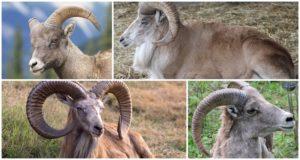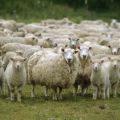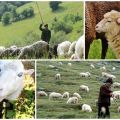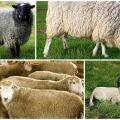Description and characteristics of Suffolk sheep, features of the content
Sheep breeding is considered one of the most developed areas of animal husbandry in the world. It is common for local farmers to adapt and breed sheep depending on environmental conditions and climate. Thanks to this, there is now such a variety of species of these animals. Around the world, the Suffolk breed of sheep, known for its productivity, endurance, and unpretentiousness, is widespread.
History of appearance
The breeding of these animals began in the distant 18th century in England in the county of Suffolk. Since 1810, the breed has been officially recognized in its homeland. By the end of the 19th century, her tribal map was developed. Russia and other countries received the opportunity to acquire these sheep only at the beginning of the 20th century.
Suffolks were bred by crossing two of the strongest species of British sheep at that time, from which they inherited important qualities for sheep breeding:
- A horned black-faced Norfolk. It is famous for its endurance in adverse conditions, quick adaptation to climate and environmental changes. He easily leads his usual way of life even in frost or constant winds thanks to a muscular body and good immunity.
- Southdown. A breed known for its abundance of wool, delicious soft meat.
Important! Thanks to the qualities acquired from the ancestors, as well as the careful selection of individuals for crossing, the Suffolk breed has become one of the most valuable in the world.
Characteristics and appearance of the breed
Outwardly, the Suffolk breed stands out in color from the rest: the head and legs of the animal are rich black, and the body is bronze yellow or white. The legs are massive, with a straight structure, without fleece wool, so Suffolk sheep exist equally well both in humid climates and in severe droughts, and the birth rate does not change from this. The tail is small, without fat deposits, the back is straight, the sacrum is compacted. The head is medium in size, without horns.

Suffolkas are tall and well muscled:
- An adult ram reaches 80 cm in length and weighs from 100 to 150 kg.
- Females - no higher than 75 cm, weigh 80-140 kg.
- Lambs are born with a weight of 4-7 kg, twins - 4-5 kg, and triplets - from 3 to 4 kg, and after 3 months with a balanced, abundant diet, the lambs reach a weight of 40 kg.
The rapid growth and weight gain of lambs is explained by the increased fat content of the mother's milk. When slaughtered, the meat yield is not less than 50% by weight. Suffolks are characterized by good hereditary memory, fertility.Females give offspring regularly every year, due to which intra-breed characteristics are preserved.
The most valuable asset among consumers is considered tasty, nutritious meat, which:
- easily absorbed by the body, does not cause severity;
- does not have a specific smell characteristic of meat of other breeds;
- it has a delicate, soft structure, not typical for lamb;
- saturated with fluorine, lecithin, and other useful substances.
The semi-fine convoluted Suffolk fleece is known throughout the world. Sheep are sheared twice a year. An adult animal gives 3-5 kg of wool, clean - at least 60%. Fiber with a diameter of 30-34 microns, a length of 7-10 cm.
Advantages and disadvantages
Sheep of this breed are adapted to humid, arid or temperate climates, retain their fertility well under adverse external conditions. Other advantages of the breed:
- resistant to parasites;
- have a high libido;
- lambs grow quickly, gain weight, are ready for the market from 5-6 months;
- give tender, nutritious, odorless meat, rich in nutrients;
- do not require special care, nutrition, unpretentious.
When crossed with other breeds, they increase fertility, improve the taste of meat from other breeds. The disadvantages include the high cost of real Suffolk lambs, frequent large and large fruits, which is complicated by heavy lambing. These animals are rare in Russia and are very difficult to acquire.

How to properly maintain and care for animals
The Suffolk breed is unpretentious, does not require special care. Animals are kept in small fenced pastures, in a corral or stall. It is not recommended to drive herds over long distances (more than 3-4 km) at high speed, this often causes limb diseases.
In summer, a common way of keeping is a pasture-stall, when animals are slowly transferred from the stall to the pasture. It is important to drive the sheep to the pasture no later than 6 in the morning, so that they spend the hot time of the day by the reservoir and by this time they are already sufficiently fed.
Features of winter content:
- Sheep and rams are kept inside a shepherd or sheepfold, which is well insulated, especially in the presence of lambs.
- Despite the fact that animals independently maintain body temperature, it is recommended to ensure that it is warm inside the room - at least 3-5 about.
- Sheds are best made of wood, with a clay floor.
- The room should be dry, light, without drafts.
Important! Suffolks do not require special care, they endure any, even extreme conditions without discomfort.
What to feed the breed
Suffolks can gain weight even on pasture. They do not require special types of feed, but experts recommend feeding them with combined feed, grain mixtures, saturated with trace elements, minerals and vitamins. In warm weather, it is advisable to feed with fresh grass in meadows and pastures. 80% of the diet, according to the rules, is grass. In cold weather, animals are given bran, hay, haylage, straw. Connoisseurs say that Suffolks love steamed straw with root crops. Also, the diet should contain chalk, bone meal, salt. Salt licks are allowed.
Important! The volume is calculated individually for each sheep.
Reproduction
Suffolks are productive, when crossed with other breeds, they give crosses with improved meat qualities. At the same time, intra-breed characteristics remain unchanged. Females give birth every year. For mating, they select the strongest, well-fed rams, as well as healthy sexually mature sheep. A six-month-old sheep is considered sexually mature. The mating occurs in August-October. Pregnancy lasts 5 months.

Fertilization occurs naturally: males are sent to females for insemination during the day, and at night they are separated, or the rams constantly remain nearby to happen at any time. During cervical fertilization, the seminal fluid of a ram is injected into the uterine cavity using a special syringe catheter.
Diseases and prevention from them
Animals do not require regular vaccinations and treatment of diseases such as hoof rot or parasitic infections. No internal or external infections are able to get along on these sheep due to the peculiarity of the body constitution.
Important! Prevention of endoparasites is recommended to avoid intense croupous nasal currents.
Breeding area
Now the British breed the breed on the territory of Suffolk, Cambridge, Essex. Sheep fell in love with farmers around the world; they are bred by residents of Europe, South and North America, New Zealand. The breed was repeatedly imported and used for crossing with other breeds in the CIS countries. There is an increased activity in breeding the species by Russian farmers, but so far there are few sheep of this breed.
Farmers who decide to take up sheep are definitely encouraged to breed a Suffolk breed. For the third century already, this breed has been considered a leader in terms of qualities important for sheep breeding: it gives high-quality meat, a lot of wool, is able to preserve hereditary characteristics, is fertile, unpretentious in care.















